BMBL MATRIX for Biosafety (BSL) and Animal ... - NCI at Frederick
BMBL MATRIX for Biosafety (BSL) and Animal ... - NCI at Frederick
BMBL MATRIX for Biosafety (BSL) and Animal ... - NCI at Frederick
You also want an ePaper? Increase the reach of your titles
YUMPU automatically turns print PDFs into web optimized ePapers that Google loves.
A guideline based on the current edition of<br />
<strong>BMBL</strong> <strong>MATRIX</strong> <strong>for</strong> <strong>Biosafety</strong> (<strong>BSL</strong>) <strong>and</strong> <strong>Animal</strong> <strong>Biosafety</strong> Level (A<strong>BSL</strong>) determin<strong>at</strong>ion<br />
the <strong>Biosafety</strong> in Microbiological <strong>and</strong> Biomedical Labor<strong>at</strong>ories (<strong>BMBL</strong>)* which is<br />
research (* http://www.cdc.gov/biosafety/public<strong>at</strong>ions/bmbl5/index.htm )<br />
to be used <strong>for</strong> determining <strong>BSL</strong> <strong>and</strong> A<strong>BSL</strong>s <strong>for</strong><br />
NOTE: The following PPE must be worn in all facilities when entering animal<br />
(or face shield). Additionally, all cage dump st<strong>at</strong>ions must be ventill<strong>at</strong>ed.<br />
rooms or labs where animals are manipul<strong>at</strong>ed: facility dedic<strong>at</strong>ed scrubs/shoes, gloves, surgical mask, eye protection<br />
MATERIAL<br />
BIOSAFETY LEVEL<br />
(applicable to<br />
injections /<br />
necropsy)<br />
ANIMAL BIOSAFETY<br />
LEVEL (applicable<br />
<strong>for</strong> animal housing /<br />
cage changes)<br />
HOUSING REQUIREMENTS CAGE CHANGES<br />
PRE / POST‐<br />
INFECTION<br />
MANIPULATIONS<br />
IMAGING<br />
MATERIALS NOT KNOWN TO BE TRANSMITTED VIA AEROSOL ROUTES (* "Retroviral" is inclusive of lentiviral vectors)<br />
1<br />
Murine cell lines transduced<br />
with an ecotropic retroviral*<br />
vector with benign insert (ex.<br />
GFP)<br />
<strong>BSL</strong>2 A<strong>BSL</strong>1 No special requirements<br />
No special requirements ‐ cages<br />
can be changed on benchtop.<br />
Bedding does not need autoclaved<br />
prior to disposal / cages do not<br />
need autoclaved prior to washing<br />
All injections <strong>and</strong><br />
necropsies in BSC <strong>for</strong><br />
DURATION of project<br />
(following <strong>BSL</strong>2<br />
practices)<br />
No special requirements<br />
2<br />
Murine cell lines transduced<br />
with an amphotropic<br />
retroviral* vector with<br />
benign insert (ex. GFP)<br />
<strong>BSL</strong>2<br />
A<strong>BSL</strong>2 <strong>for</strong> 1 week /<br />
then A<strong>BSL</strong>1<br />
Microisol<strong>at</strong>or technique <strong>for</strong><br />
1 week post‐dosing; after 1<br />
week, no special<br />
requirements<br />
For first week: 1. ALL cage<br />
changes in BSC; 2. bag <strong>and</strong><br />
autoclave bedding; 3. bag <strong>and</strong><br />
autoclave caging be<strong>for</strong>e wash;<br />
After one week, resume normal<br />
cage change.<br />
All injections <strong>and</strong><br />
necropsies in BSC <strong>for</strong><br />
DURATION of project<br />
(following <strong>BSL</strong>2<br />
practices)<br />
Imaging ‐ all manipul<strong>at</strong>ions<br />
inside BSC where feasible.<br />
Maintain <strong>BSL</strong>2/A<strong>BSL</strong>2<br />
practices where feasible,<br />
especially during the first<br />
week.<br />
3<br />
Murine cell lines transduced<br />
with an ecotropic retroviral*<br />
vector with 'hot' insert (ex.<br />
oncogene )<br />
<strong>BSL</strong>2 A<strong>BSL</strong>1 No special requirements<br />
No special requirements ‐ cages<br />
can be changed on benchtop.<br />
Bedding does not need autoclaved<br />
prior to disposal / cages do not<br />
need autoclaved prior to washing<br />
All injections <strong>and</strong><br />
necropsies in BSC <strong>for</strong><br />
DURATION of project<br />
(following <strong>BSL</strong>2<br />
practices)<br />
No special requirements<br />
4<br />
Murine cell lines transduced<br />
with an amphotropic<br />
retroviral* vector with 'hot'<br />
insert (ex. oncogene)<br />
<strong>BSL</strong>2<br />
A<strong>BSL</strong>2 <strong>for</strong> 1 week /<br />
then A<strong>BSL</strong>1<br />
Microisol<strong>at</strong>or technique <strong>for</strong><br />
1 week post‐dosing; after 1<br />
week, no special<br />
requirements<br />
For first week: 1. ALL cage<br />
changes in BSC; 2. bag <strong>and</strong><br />
autoclave bedding; 3. bag <strong>and</strong><br />
autoclave caging be<strong>for</strong>e wash;<br />
After one week, resume normal<br />
cage change.<br />
All injections <strong>and</strong><br />
necropsies in BSC <strong>for</strong><br />
DURATION of project<br />
(following <strong>BSL</strong>2<br />
practices)<br />
Imaging ‐ all manipul<strong>at</strong>ions<br />
inside BSC where feasible.<br />
Maintain <strong>BSL</strong>2/A<strong>BSL</strong>2<br />
practices where feasible,<br />
especially during the first<br />
week.<br />
Revised by FNLCR‐IBC on 04/17/12<br />
Approved by FNLCR‐IBC on 03/20/12<br />
Page 1 of 4 5/21/2012
A guideline based on the current edition of<br />
<strong>BMBL</strong> <strong>MATRIX</strong> <strong>for</strong> <strong>Biosafety</strong> (<strong>BSL</strong>) <strong>and</strong> <strong>Animal</strong> <strong>Biosafety</strong> Level (A<strong>BSL</strong>) determin<strong>at</strong>ion<br />
the <strong>Biosafety</strong> in Microbiological <strong>and</strong> Biomedical Labor<strong>at</strong>ories (<strong>BMBL</strong>)* which is<br />
research (* http://www.cdc.gov/biosafety/public<strong>at</strong>ions/bmbl5/index.htm )<br />
to be used <strong>for</strong> determining <strong>BSL</strong> <strong>and</strong> A<strong>BSL</strong>s <strong>for</strong><br />
NOTE: The following PPE must be worn in all facilities when entering animal<br />
(or face shield). Additionally, all cage dump st<strong>at</strong>ions must be ventill<strong>at</strong>ed.<br />
rooms or labs where animals are manipul<strong>at</strong>ed: facility dedic<strong>at</strong>ed scrubs/shoes, gloves, surgical mask, eye protection<br />
MATERIAL<br />
BIOSAFETY LEVEL<br />
(applicable to<br />
injections /<br />
necropsy)<br />
ANIMAL BIOSAFETY<br />
LEVEL (applicable<br />
<strong>for</strong> animal housing /<br />
cage changes)<br />
HOUSING REQUIREMENTS CAGE CHANGES<br />
PRE / POST‐<br />
INFECTION<br />
MANIPULATIONS<br />
IMAGING<br />
5<br />
Murine cell lines transduced<br />
with an pantropic retroviral*<br />
vector with 'hot' insert (ex.<br />
oncogene)<br />
<strong>BSL</strong>2<br />
A<strong>BSL</strong>2 <strong>for</strong> 1 week /<br />
then A<strong>BSL</strong>1<br />
Microisol<strong>at</strong>or technique <strong>for</strong><br />
1 week post‐dosing; after 1<br />
week, no special<br />
requirements<br />
For first week: 1. ALL cage<br />
changes in BSC; 2. bag <strong>and</strong><br />
autoclave bedding; 3. bag <strong>and</strong><br />
autoclave caging be<strong>for</strong>e wash;<br />
After one week, no special<br />
requirements<br />
All injections <strong>and</strong><br />
necropsies in BSC <strong>for</strong><br />
DURATION of project<br />
(following <strong>BSL</strong>2<br />
practices)<br />
Imaging ‐ all manipul<strong>at</strong>ions<br />
inside BSC where feasible.<br />
Maintain <strong>BSL</strong>2/A<strong>BSL</strong>2<br />
practices where feasible,<br />
especially during the first<br />
week.<br />
6<br />
Unmodified murine<br />
mice<br />
cells into<br />
<strong>BSL</strong>1 A<strong>BSL</strong>1 No special requirements<br />
No special requirements ‐ cages<br />
can be changed on benchtop.<br />
Bedding does not need autoclaved<br />
prior to disposal / cages do not<br />
need autoclaved prior to washing<br />
No special<br />
requirements<br />
No special requirements<br />
MATERIALS KNOWN TO BE TRANSMITTED VIA AEROSOL ROUTES<br />
7<br />
Adenovirus/Adeno‐Cre;<br />
Adenoviral vectors; cells<br />
transduced with adenoviral<br />
vectors<br />
<strong>BSL</strong>2<br />
A<strong>BSL</strong>2 <strong>for</strong> 1 week /<br />
then A<strong>BSL</strong>1<br />
Microisol<strong>at</strong>or technique <strong>for</strong><br />
1 week post‐dosing; after 1<br />
week, no special<br />
requirements<br />
For first week: 1. ALL cage<br />
changes in BSC; 2. bag <strong>and</strong><br />
autoclave bedding; 3. bag <strong>and</strong><br />
autoclave caging be<strong>for</strong>e wash;<br />
After one week, resume normal<br />
cage change.<br />
All injections <strong>and</strong><br />
necropsies in BSC <strong>for</strong><br />
DURATION of project<br />
(following <strong>BSL</strong>2<br />
practices)<br />
Imaging ‐ all manipul<strong>at</strong>ions<br />
inside BSC where feasible.<br />
Maintain <strong>BSL</strong>2/A<strong>BSL</strong>2<br />
practices where feasible,<br />
especially during the first<br />
week.<br />
8<br />
Known Human P<strong>at</strong>hogens<br />
(ex. Toxoplasma gondii;<br />
Listeria monocytogenes;<br />
Helicobacter pylori; LCMV;<br />
Citrobacter rodentium;<br />
Certain toxins (i.e.<br />
Diphtheria); others as<br />
reviewed by IBC<br />
<strong>BSL</strong>2 A<strong>BSL</strong>2<br />
Microisol<strong>at</strong>or technique <strong>for</strong><br />
DURATION of experiment<br />
For first week: 1. ALL cage<br />
changes in BSC; 2. bag <strong>and</strong><br />
autoclave bedding; 3. bag <strong>and</strong><br />
autoclave caging be<strong>for</strong>e wash;<br />
After one week, resume normal<br />
cage change.<br />
All injections <strong>and</strong><br />
necropsies in BSC <strong>for</strong><br />
DURATION of project<br />
(following <strong>BSL</strong>2<br />
practices)<br />
Imaging ‐ all manipul<strong>at</strong>ions<br />
inside BSC where feasible.<br />
Maintain <strong>BSL</strong>2/A<strong>BSL</strong>2<br />
practices where feasible<br />
Revised by FNLCR‐IBC on 04/17/12<br />
Approved by FNLCR‐IBC on 03/20/12<br />
Page 2 of 4 5/21/2012
A guideline based on the current edition of<br />
<strong>BMBL</strong> <strong>MATRIX</strong> <strong>for</strong> <strong>Biosafety</strong> (<strong>BSL</strong>) <strong>and</strong> <strong>Animal</strong> <strong>Biosafety</strong> Level (A<strong>BSL</strong>) determin<strong>at</strong>ion<br />
the <strong>Biosafety</strong> in Microbiological <strong>and</strong> Biomedical Labor<strong>at</strong>ories (<strong>BMBL</strong>)* which is<br />
research (* http://www.cdc.gov/biosafety/public<strong>at</strong>ions/bmbl5/index.htm )<br />
to be used <strong>for</strong> determining <strong>BSL</strong> <strong>and</strong> A<strong>BSL</strong>s <strong>for</strong><br />
NOTE: The following PPE must be worn in all facilities when entering animal<br />
(or face shield). Additionally, all cage dump st<strong>at</strong>ions must be ventill<strong>at</strong>ed.<br />
rooms or labs where animals are manipul<strong>at</strong>ed: facility dedic<strong>at</strong>ed scrubs/shoes, gloves, surgical mask, eye protection<br />
MATERIAL<br />
BIOSAFETY LEVEL<br />
(applicable to<br />
injections /<br />
necropsy)<br />
ANIMAL BIOSAFETY<br />
LEVEL (applicable<br />
<strong>for</strong> animal housing /<br />
cage changes)<br />
HOUSING REQUIREMENTS CAGE CHANGES<br />
PRE / POST‐<br />
INFECTION<br />
MANIPULATIONS<br />
IMAGING<br />
HUMAN CELL LINES<br />
(* "Retroviral" is inclusive of lentiviral vectors)<br />
9<br />
Unmodified (established)<br />
Human cell lines inserted<br />
into an<br />
immunocompromised mouse<br />
<strong>BSL</strong>2 A<strong>BSL</strong>1 No special requirements<br />
No special requirements ‐ cages<br />
can be changed on benchtop.<br />
Bedding does not need autoclaved<br />
prior to disposal / cages do not<br />
need autoclaved prior to washing<br />
All injections <strong>and</strong><br />
necropsies in BSC <strong>for</strong><br />
DURATION of project<br />
(following <strong>BSL</strong>2<br />
practices)<br />
No special requirements<br />
10<br />
Human cell lines transduced<br />
with retroviral* vector then<br />
inserted into an<br />
immunocompromised mouse<br />
<strong>BSL</strong>2<br />
A<strong>BSL</strong>2 <strong>for</strong> 1 week /<br />
then A<strong>BSL</strong>1<br />
Microisol<strong>at</strong>or technique <strong>for</strong><br />
1 week post‐dosing; after 1<br />
week, no special<br />
requirements<br />
For first week: 1. ALL cage<br />
changes in BSC; 2. bag <strong>and</strong><br />
autoclave bedding; 3. bag <strong>and</strong><br />
autoclave caging be<strong>for</strong>e wash;<br />
After one week, resume normal<br />
cage change.<br />
All injections <strong>and</strong><br />
necropsies in BSC <strong>for</strong><br />
DURATION of project<br />
(following <strong>BSL</strong>2<br />
practices)<br />
Imaging ‐ all manipul<strong>at</strong>ions<br />
inside BSC where feasible.<br />
Maintain <strong>BSL</strong>2/A<strong>BSL</strong>2<br />
practices where feasible,<br />
especially during the first<br />
week.<br />
11<br />
PRIMARY human tissue<br />
transplant into mice<br />
<strong>BSL</strong>2 A<strong>BSL</strong>2<br />
Microisol<strong>at</strong>or technique <strong>for</strong><br />
DURATION of experiment<br />
1. ALL cage changes in BSC; 2.<br />
bag <strong>and</strong> autoclave bedding; 3. bag<br />
<strong>and</strong> autoclave caging be<strong>for</strong>e wash<br />
All injections <strong>and</strong><br />
necropsies in BSC <strong>for</strong><br />
DURATION of project<br />
(following <strong>BSL</strong>2<br />
practices)<br />
Imaging ‐ all manipul<strong>at</strong>ions<br />
inside BSC where feasible.<br />
Maintain <strong>BSL</strong>2/A<strong>BSL</strong>2<br />
practices where feasible<br />
Revised by FNLCR‐IBC on 04/17/12<br />
Approved by FNLCR‐IBC on 03/20/12<br />
Page 3 of 4 5/21/2012
A guideline based on the current edition of<br />
<strong>BMBL</strong> <strong>MATRIX</strong> <strong>for</strong> <strong>Biosafety</strong> (<strong>BSL</strong>) <strong>and</strong> <strong>Animal</strong> <strong>Biosafety</strong> Level (A<strong>BSL</strong>) determin<strong>at</strong>ion<br />
the <strong>Biosafety</strong> in Microbiological <strong>and</strong> Biomedical Labor<strong>at</strong>ories (<strong>BMBL</strong>)* which is<br />
research (* http://www.cdc.gov/biosafety/public<strong>at</strong>ions/bmbl5/index.htm )<br />
to be used <strong>for</strong> determining <strong>BSL</strong> <strong>and</strong> A<strong>BSL</strong>s <strong>for</strong><br />
NOTE: The following PPE must be worn in all facilities when entering animal<br />
(or face shield). Additionally, all cage dump st<strong>at</strong>ions must be ventill<strong>at</strong>ed.<br />
rooms or labs where animals are manipul<strong>at</strong>ed: facility dedic<strong>at</strong>ed scrubs/shoes, gloves, surgical mask, eye protection<br />
MATERIAL<br />
BIOSAFETY LEVEL<br />
(applicable to<br />
injections /<br />
necropsy)<br />
ANIMAL BIOSAFETY<br />
LEVEL (applicable<br />
<strong>for</strong> animal housing /<br />
cage changes)<br />
HOUSING REQUIREMENTS CAGE CHANGES<br />
PRE / POST‐<br />
INFECTION<br />
MANIPULATIONS<br />
IMAGING<br />
Revised by FNLCR‐IBC on 04/17/12<br />
Approved by FNLCR‐IBC on 03/20/12<br />
Page 4 of 4 5/21/2012


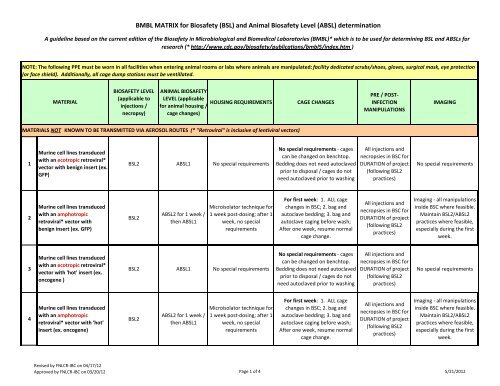
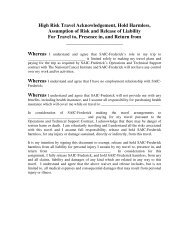
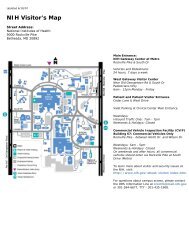
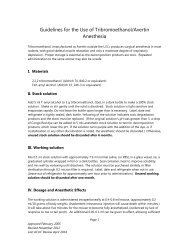
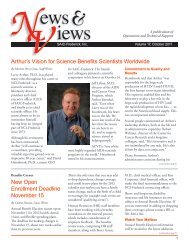
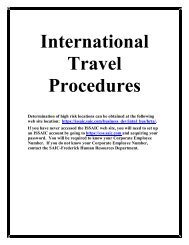

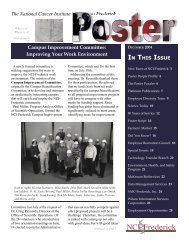
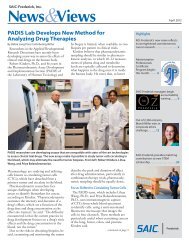

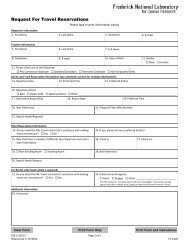
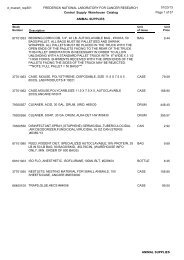
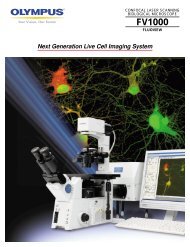
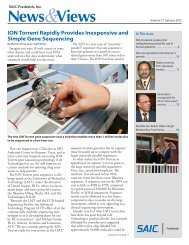
![View Full Cafe Menu [PDF] - NCI at Frederick](https://img.yumpu.com/28168409/1/190x253/view-full-cafe-menu-pdf-nci-at-frederick.jpg?quality=85)